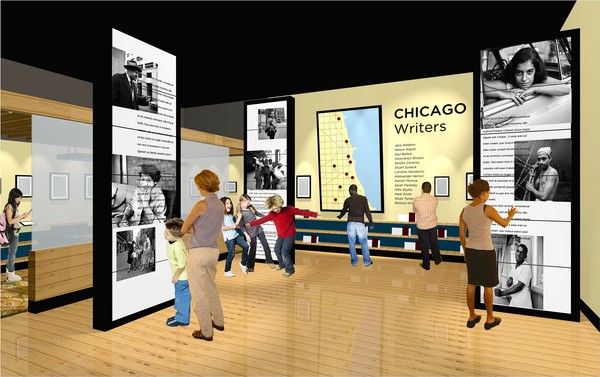As Malcolm O’Hagan sees it, the story has the makings of a good novel. Consider the plot: An Irishman born in Yeats country falls in love with American literature after reading John Steinbeck’s Grapes of Wrath and the short stories of Ernest Hemingway.
Decades later, he devotes his retirement years to create a museum dedicated to its authors.
The novel’s setting? Chicago. O’Hagan, 73, is arriving in the Windy City this week to work out final plans for a $10 million capital campaign to launch the American Writers Museum, slated to open in 2015. Already, he has raised $300,000 through personal donations and grants from the Chicago Community Trust and the National Endowment for the Humanities. The capital campaign is expected to begin early next month.
A confessed bibliophile who owns 3,000 books and reads at least five at once, O’Hagan says the idea came to him after many visits to the Dublin Writers Museum celebrating Irish literature. For months he turned over the question of why there wasn’t such a place in the U.S., until suddenly realizing he had a simple answer: No one had made it happen.
“I knew that I would have to start it up,” says O’Hagan, a retired executive who lives in Washington, D.C. In 2010, he formed the non-profit American Writers Museum Foundation with the mission of creating a “hub for national discourse on writers and writing.”
But rather than the dusty writers’ houses of generations past, O’Hagan envisions a modern, interactive space modeled after D.C.’s Spy Museum and the Rock and Roll Hall of Fame in Cleveland. Recordings of authors reading their work would play in sound rooms. Characters would come alive in a children’s gallery where a word tornado spins and benches are shaped like giant erasers. A literary map would allow visitors to wander through The House of the Seven Gables or, as O’Hagan suggests, follow the cross-country journey mythologized in On the Road.
“The essential literary experience, of course, takes place in silence inside a book,” former U.S. Poet Laureate Billy Collins, a project supporter, wrote in an email. “But why shouldn’t the abundant joy of American writing have its own museum, a physical place that readers can walk into and learn and marvel?”
But where to build? Cities rich with a literary history are many. New York. Boston. San Francisco. O’Hagan says board members, among whom include Terry Stewart, retired CEO of the Rock and Roll Museum, J.S. Bindenagel, vice president of DePaul University, and Dr. Tom Staley, director of the Harry Ransom Center at the University of Texas, wanted a central city, but one with a textured, gritty history. Minneapolis called. Chicago, however, fit the bill.
In an email, poet Nikki Giovanni, another prominent supporter, describes the city’s literary appeal this way:
The train line goes from Mississippi to Chicago. The people bled out of the horror into the promise. Chicago was cold and mean but you could live. The music informed the history; the stories followed the music. Chicago is an incredibly important city because it kept the South alive — the good South of music and muse. This museum is great! Long overdue. To quote the blues song, “Going to Chicago — Glad that I can take you.
What’s more, Chicago is home to the Poetry Foundation and Poetry magazine, which in 2011 unveiled its new headquarters built with $200 million bequeathed by the late Ruth Lilly, heiress to pharmaceutical giant Eli Lilly and Company. The city is also home to the American Library Association and the Chicago Literary Hall of Fame, which honors authors such as Upton Sinclair and Theodore Dreiser who laid the foundation of a Chicago School of Fiction in the early 20th century. (Later came Richard Wright, Upton Sinclair, Nelson Algren, Saul Bellow, Gwendolyn Brooks, Studs Terkel, Sandra Cisneros, Stuart Dybek, Ana Castillo, Aleksandar Hemon and David Mamet.)
Eventually, the foundation hopes to raise $100 million and build a 60,000-square-foot permanent home for the museum. “Our thought is there’s definitely a philanthropist out there who loves books and wants to be part of this legacy,” O’Hagan says. Other cities have made overtures, and the American Writers Museum board would give them consideration if, O’Hagan says, “they can show me the money.”
Getting to that point won’t be easy. Last June, a study conducted by the University of Chicago’s Cultural Policy Center examined the feasibility of constructing new institutions in the wake of a cultural building boom between 1994 and 2008. The researchers studied more than 700 building projects and found that project costs frequently exceeded budgets without bringing the anticipated benefits or attracting the anticipated number of visitors.
For example, the Art Institute of Chicago’s new Renzo Piano-designed modern wing opened in May 2009 at a cost of $294 million. Ten years into the planning, museum executives were banking on the belief that the flashy new addition would boost attendance. Instead, it raised operating costs by an estimated $4 million and created the need for an additional $87 million in fundraising to expand the endowment, while not attracting the crowds needed to sustain operations.
The endowment decline led to layoffs, pay cuts, salary freezes and furloughs. In the end, the museum was forced to make difficult slashes to the budget. The study’s findings suggest that rather than build, institutions should consider adaptive reuse of existing buildings “and cultural districts linking various smaller organizations.”
The challenge, however, does not intimidate O’Hagan or his supporters — every good story needs a conflict, after all.
“Such a project is overdue, really,” novelist Rick Moody writes in an email. “And Chicago, notable not only for its topographical location, but also for its own unique brand of literary fiction and non-fiction, is the perfect situation for the museum. It’s something to look forward to in the cultural ferment of the Midwest.”
Lori Rotenberk is an award-winning journalist based in Chicago. Her work appears on Grist and Civil Eats. She’s written for the Boston Globe and the New York Times and was a staff reporter at the Chicago Sun-Times.















